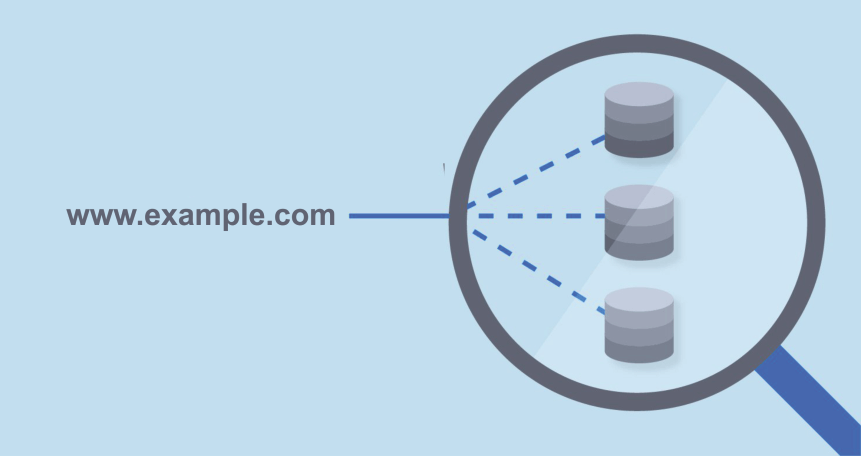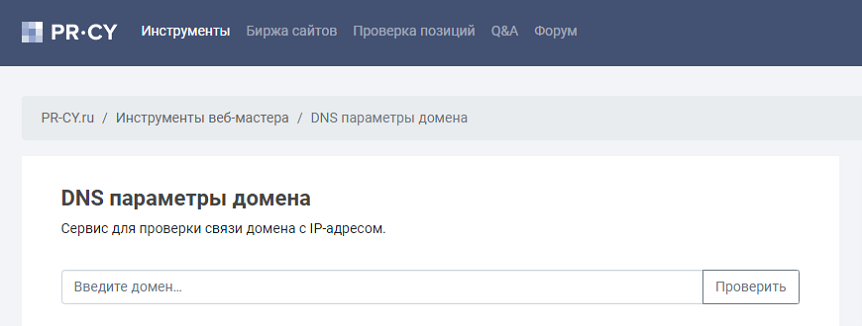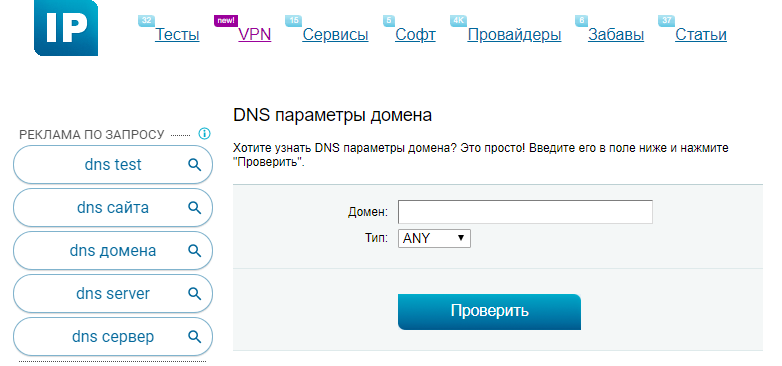The DNS Lookup finds all DNS records of a given domain name. The DNS records include but are not limited to A, AAAA, CNAME, MX, NS, PTR, SRV, SOA, TXT, CAA, DS, and DNSKEY.
Данный сервис предоставляет возможность узнать все записи с DNS сервера для указанного домена или поддомена. Будет полезен для определения наличия той или иной записи на DNS сервере и ее значения. Так же поможет узнать параметр TTL. Укажите домен или поддомен, DNS сервер будет определен автоматически.
- About the SuperTool!
- What is a DNS CNAME record?
- What is a CNAME example?
- Интересно и полезно
- Monitorus – теперь вы не потеряете своих посетителей!
- Как правильно рассылать письма и не попадать в СПАМ?
- Старт открытой регистрации доменов МОСКВА и MOSCOW
- Зачем проверять DNS-записи
- Windows и Linux утилиты для проверки DNS-записей
- Управление DNS-записями
- Предварительные требования
- Создание DNS-записи в ISPmanager
- What is a domain name system, and what type of DNS servers are involved in the DNS check process?
- How to perform the CNAME record lookup to check the CNAME records?
- Manual checking of the CNAME records
- 1: CNAME Lookup on Windows-based systems
- 2: CNAME Lookup on Linux and Mac systems
- Checking of the CNAME records using a CNAME record Checker online
- Проверка домена
- Some restrictions on CNAME records
- How is a domain name translated to an IP address?
- DNS Lookup Flow — Eight-Step Process
- Forward DNS Lookup
- Reverse DNS Lookup
- Лучшие бесплатные сервисы для проверки DNS-записей
- Pr-C y
- Основные возможности
- Особенности
- 2whois
- Основные возможности
- Особенности
- 2ip
- Основные возможности
- Особенности
- MXToolbox
- Основные возможности
- Особенности
- NetTOOLS
- Основные возможности
- Особенности
- functions-online
- Основные возможности
- Особенности
- CNAME Lookup — Online CNAME Checker
- What is a DNS record?
- Different Types of DNS Records
- How does the DNS process work?
- What are the common uses of CNAME records?
- DNS Propagation Checker — How to Check DNS Propagation Globally
- What is DNS propagation?
- What is DNS resolution?
- How do DNS records propagate?
- Why DNS propagation takes time?
- Why is DNS not propagating?
- Which are the best DNS servers?
- FAQs
- What will happen if the domain name does not exist?
- What is the port used by DNS?
- What is DNS failure?
- DNS Record Lookup — Check All DNS Records for Any Domain
- What types of DNS records can be looked up using the Dig (DNS Lookup)?
- Вывод
About the SuperTool!
All of your MX record, DNS, blacklist and SMTP diagnostics in one integrated tool. Input a domain name or IP Address or Host Name. Links in the results will guide you to other relevant tools and information. And you’ll have a chronological history of your results.
If you already know exactly what you want, you can force a particular test or lookup. Try some of these examples:
(e.g. «blacklist: 127.0.0.2» will do a blacklist lookup)
Feedback: If you run into any problems with the site or have an idea that you think would make it better, we would appreciate your feedback. Please leave us some Feedback.
13 марта 2020
Время чтения ≈ 10 минут

Специальные сервисы помогают правильно указать DNS-записи, проверить их наличие и корректность настройки. Это значительно упрощает жизнь системного администратора, веб-мастера и разработчика. О лучших бесплатных онлайн-сервисах для проверки DNS-записей расскажем в этой статье.

Наиболее важные типы DNS-записей приведены в списке ниже.
- A-запись — находит IP-адрес сервера по введенному названию сайта в адресную строку браузера.
- CNAME-запись — указывает на несколько поддоменов на одном сервере.
- MX-запись — указывает сервер, который отвечает за прием почты для данного домена.
- TXT-запись — информационная запись с информацией для внешних источников (хранит до 255 байт). Часто используется для подтверждения прав собственности на домен.
Подробно о работе DNS и типах записей можно прочитать в нашей базе знаний.
При привязке домена к сайту используется два типа DNS-серверов — первичные и вторичные. Первые хранят ресурсные записи о самом домене, а вторые предназначены для ретрансляции этих же записей.
Собственно, настройка услуги DNS-хостинга представляет собой управление DNS-записями, но если вы приобрели услугу виртуальный хостинг Eternalhost, то управление DNS-записями можно выполнить через панель ISPmanager.
DNS-записи отличаются между собой по типам в зависимости от функционала. Ниже приведен список основных типов ресурсных записей:
- A-запись — предназначена для связки хостинга и домена. Для адресов в формате IPv6 используется аналогичный тип — AААА-запись.
- MX-запись — отвечает за настройку почтового сервера.
- NS — эти записи хранят информацию об адресах DNS-серверов, которые обслуживают домен.
- CNAME — синонимы домена. Позволяют указать, что адрес с приставкой www и без нее — это один сайт.
- TXT-записи позволяют добавить текстовое примечание, чтобы зарегистрировать дополнительные параметры информации домене:
✔ активировать сертификат SSL;
✔ подтвердить права на владение доменным именем для отдельных сервисов (например Google Search Console);
✔ подключить к почтовому серверу DMARC.
✔ добавить подтверждение домена при отправке почты с помощью DKIM;
✔ защитить отправку писем с помощью записи SPF.
Подробнее о DNS-записях и их предназначении можно узнать из этой статьи.
What is a DNS CNAME record?
A CNAME record, canonical name, or alias record is a DNS record type used in place of an A (for IPv4) or AAAA (for IPv6) record when the domain or subdomain is an alias of another domain.
What is a CNAME example?
An example of a CNAME record is
In the above example,
- www is the subdomain and is an identifier of the record.
- CNAME is the DNS record type.
- com is the value of the record. That means www will resolve to the IP address of the domain abc.com.
- 3600 is TTL (time to live) is the expiry time of the CNAME record. It’s expressed in seconds. Here 3600 means that the records will be updated after each hour.
Интересно и полезно

Monitorus – теперь вы не потеряете своих посетителей!
- 26 июля 2018

Как правильно рассылать письма и не попадать в СПАМ?
- 03 декабря 2014

Старт открытой регистрации доменов МОСКВА и MOSCOW
- 03 декабря 2014
Разместить новость своей компании на этом месте
Зачем проверять DNS-записи
Ошибки в ресурсных записях DNS могут стать причиной того, что сайт станет недоступен на длительное время. Ведь, даже при внесении правок, изменения вступят в силу только в течение 72 часов. Проверка DNS-записей помогает убедиться в их правильной настройке и работоспособности.

Windows и Linux утилиты для проверки DNS-записей
Утилиты для проверки посылают специальные запросы, чтобы проверить существование и значение DNS-записей. Проверить можно одну запись, или несколько сразу. Ниже приведены наиболее распространенные утилиты проверки DNS-записей для Windows и Linux.
- NSLookUp (Linux, Windows). Встроенная утилита позволяет узнать точные данные об IP-адресе домена (включая скорость получения), а также о настройке всех DNS-записей для него. В Windows запускается командой nslookup -type=<тип записи> example.com в командной строке (где вместо «example.com» нужно подставить нужный сайт). В Linux это делается аналогичным образом.
- Dig — «Domain information groper» (Linux, Windows). Аналог NSLookUp, входящий в базовую комплектацию программного обеспечения к DNS-серверу BIND.
- DNSBasic (Windows). Утилита диагностики домена, которая, помимо прочих функций, опрашивает DNS-записи сервера.
- Host (Linux). Стандартная утилита в командной строке для проведения всех видов запросов к DNS-серверу.
Управление DNS-записями
Настройка DNS-записей осуществляется двумя основными способами:
- Самостоятельно — через панель управления виртуальным хостингом.
- Через услугу DNS-хостинга, предоставляемую хостинг-провайдером.
Второй способ используют в крайнем случае — если нельзя воспользоваться панелью управления или нет возможности настроить свой DNS-сервер. Подробнее о DNS-хостинге и его практическом использовании можно почитать здесь.
Далее рассмотрим подробнее перенос домена через панель управления веб-хостингом на примере наиболее популярного варианта — ISPmanager.
Предварительные требования
Если вы хотите управлять DNS-записями домена через ISPmanager на виртуальном хостинге Eternalhost, то нужно выполнить ряд требований:
- Домен должен ссылаться на NS-сервера хостинга:
Данная настройка выполняется на регистраторе домена (сайте, где вы регистрировали домен). К примеру, для доменов, купленных на Eternalhost, указание NS-серверов осуществляется в биллинг-панели. В левом меню нужно в разделе «Товары/Услуги», выбрать «Домены», выбрать нужный домен и нажать «NS» в верхнем меню.

- У вас должна быть приобретенная услуга виртуальный хостинг.
- Домен должен быть добавлен на вашем виртуальном хостинге в разделе «Основное» → «Доменные имена». Данное действие выполняется автоматически при создании WWW-домена в панели ISPmanager.
Создание DNS-записи в ISPmanager
- Нужно войти в панель ISPmanager и открыть раздел «Доменные имена», а затем нажать на название редактируемого домена и «Управлять DNS записями».

- Далее перейти в «Записи» и на новой странице нажать «Создать запись».

- В этом окне остается указать тип создаваемой записи и необходимые параметры, в зависимости от выбора.

- Остается добавить DNS-запись нажатием кнопки «ОК». В течение часа изменения будут приняты.

What is a domain name system, and what type of DNS servers are involved in the DNS check process?
Domain Name System (DNS) is a hierarchical decentralized system that maps domain names to IP addresses. It is the internet’s equivalent of a phone book, mapping human-readable domain names to IP addresses.
There are three types of DNS servers involved in the DNS resolution process:
- Recursive DNS server (DNS resolver): These servers are the first in the DNS check process. Receive DNS queries from clients and resolve the human-readable domain name to an IP address. That server tracks the IP address for the searched domain or hostname.
- Root DNS servers: These servers are at the top of the DNS hierarchy and provide a list of top-level domain (TLD) servers to resolvers.
- Authoritative DNS servers: These servers are the last stop in the DNS resolution process. The authoritative nameservers for the searched domain hold the actual DNS records and respond to queries with the correct IP addresses.
How to perform the CNAME record lookup to check the CNAME records?
There are two ways to perform the DNS CNAME Lookup: manual checking to check domain CNAME or a CNAME lookup tool.
Manual checking of the CNAME records
You can divide it into two parts
1: CNAME Lookup on Windows-based systems
Windows-based systems, including Windows 7, Windows 10 & Windows Server, use the nslookup command to perform the CNAME Lookup using your local resolver or specify any public recursive resolver.
For locally configured resolver
nslookup
> set q=cname
> www.abc.com
For any specific public recursive resolver
nslookup
> set q=cname
> server 8.8.8.8
> www.abc.com
2: CNAME Lookup on Linux and Mac systems
On Linux and Mac-based systems, including Mac OS X, macOS, Ubuntu, Debian, CentOS & Red Hat, you can use the host command or dig command to perform the CNAME Lookup using your local resolver or specify any public recursive resolver.
Using the host command
For locally configured resolver host -t cname www.abc.com
For any specific public recursive resolver host -t cname www.example.com 8.8.8.8
Using the dig command
For locally configured resolver dig www.abc.com cname
Checking of the CNAME records using a CNAME record Checker online
- Open the CNAME Lookup Tool to check CNAME records.
- Enter the domain name and select the DNS server. You can choose between Google DNS, Cloudflare DNS, OpenDNS, Quad9, Yandex DNS, and Authoritative DNS servers.
- Click on the «Fetch CNAME Records» button.
- The tool will perform the CNAME lookup, list a given domain’s CNAME record(s).
- Also, check CNAME records through multiple DNS servers worldwide with the WhatsMyDNS tool.
Проверка домена
От ошибок никто не застрахован и часто во время работы домена возникают неполадки. Например, перестала отправляться или доходить электронная почта. В таком случае следует посмотреть DNS-записи домена. Сделать это можно через бесплатные онлайн-сервисы, подробнее о которых можно узнать из этой статьи.
Даже если домен работает правильно, нелишним будет периодически проверять его. Это позволит преждевременно исправить возможные ошибки. Тем более, из-за малейшего недосмотра доступ к сайту может оказаться закрытым.
Some restrictions on CNAME records
- The CNAME record cannot be placed at the root domain level. Because the root domain level is the DNS Start of Authority (SOA), that must point to an IP address.
- The CNAME must point to another valid domain or subdomain, not an IP address.
- The hostname defined in the CNAME record must not have other records present except for DNSSEC records (RRSIG, DNSKEY, DS, NSEC, and NSEC3PARAM).
- The MX record or NS record cannot point to the CNAME alias.
- The CNAME record can point to another CNAME record, but it involves several DNS Lookup queries. That’s technically not recommended because it slows down the user experience.
- The CNAME records do not always resolve to the same website as the domain it points to. The CNAME record only points to the IP of the root domain.
- You can set at most one CNAME record for a domain or subdomain.
How is a domain name translated to an IP address?
DNS stands for Domain Name System. The system converts a hostname (dnschecker.org) to a computer-friendly IP address.
Consider DNS domain lookup as a map or phone book to find your respective searches for a better understanding.
As discussed, humans cannot learn long number strings (IP Addresses). Therefore, by simply typing the website’s name (www.amazon.com), the DNS server provides the IP Address associated with that domain.
The DNS server can either be on ISP or your local network. Other devices, such as routers, access the translated domain (into IP address) to channel your search results.
DNS Lookup Flow — Eight-Step Process
The flow of the DNS lookup process for domain example.com involves several steps.
- Requesting domain information: It starts with a client typing the domain “example.com” in its browser bar.
- Contact the recursive DNS server: The browser sends a DNS query to its configured DNS resolver (a recursive resolver) (e.g., the router or ISP’s DNS server).
- Return DNS record if present: The recursive resolver checks its cache to see if it has a recent copy of the DNS record. If so, it returns the DNS record to the client.
- Sending DNS query to root nameserver: If the recursive resolver does not have a recent record copy, it sends a query to one of the root nameservers.
- Contacting TLD nameserver: The root nameserver returns with an address of the top-level domain (TLD) nameserver (e.g., the .com TLD nameserver in that case) responsible for the domain in question.
- Referring to authoritative nameserver: The TLD nameserver refers to the authoritative nameserver for the specific domain.
- Access the DNS record: The recursive resolver sends a request to the authoritative nameserver that responds with the requested DNS record to the recursive resolver, which it caches and then returns to the client.
- Final Step: The client uses the information from the DNS record to connect to the IP address of the server hosting the website.
Each DNS request also returns a TTL (time to live) value specifying the time (in seconds) for which the DNS record is cached. When you change your DNS servers, it usually takes 24 to 48 hours for the DNS records to propagate globally. You can go for my DNS check to check whether your domain DNS records are propagated globally.
Forward DNS Lookup
Reverse DNS Lookup
Contrary to forwarding DNS Lookup, DNS reverse lookup identifies the domain name using the IP Address. Email servers use this lookup method to identify valid receivers.
Лучшие бесплатные сервисы для проверки DNS-записей
Без специальных знаний разобраться с утилитами может быть не просто. В таком случае, можно проверить DNS-записи домена через онлайн-сервисы. Они значительно помогают упростить процесс проверки.
Pr-Cy

Многофункциональный портал для владельцев и администраторов сайта, SEO-специалистов и копирайтеров. Простой в использовании сервис поможет выполнить полную проверку сайта, даже новичку. Большая часть функций доступна бесплатно. Сервис умеет проверять следующие типы DNS-записей: TXT, MX, A, SOA, NS.
Основные возможности
- Полная проверка DNS-записей.
- Измерение скорости соединения с сервером.
- Проверка IP-адреса заданного хоста.
- Вывод заголовков сервера.
- Автоматический контроль за доступностью сайта.
- Вывод WHOIS-информации по домену.
- Проверка портов на доступность — способность принимать входящие подключения.
- Контроль за посещаемостью сайта.
- Проверка IP-адреса в спам-базах.
Особенности
Большая часть функций доступна бесплатно и без регистрации. Сообщество помогает разобраться в сложных вопросах. На бирже сайтов, можно купить уже готовый проект.
2whois

Удобный и бесплатный сервис для системных администраторов и веб-мастеров, разработчики которого решили сфокусироваться на технической стороне проверки. Сервис умеет проверять следующие типы DNS-записей: TXT, MX, A, SOA, NS, PTR.
Основные возможности
- Проверка DNS-записей.
- Вывод WHOIS-информации о домене.
- Встроенная поддержка распространенных утилит (NSLookUp, Dig, PTR).
- Возможность проверки пинга (ping) сайта.
- Вывод полного маршрута пакетов до конечного сервера через Traceroute.
- Контроль работоспособности сайта из различных точек земного шара.
Дополнительно, поможет проверить сайт на вирусы и его наличие в базах Роскомнадзора и в спам-базах.
Особенности
Полностью работает без регистрации, несмотря на ее наличие. Здесь она используется для сохранения проверок и большего удобства. Достаточно, зайти на сайт ввести в поле адрес сайта, нажать кнопку «Проверить». Практически сразу, можно приступать к изучению результатов.
2ip

Еще один многофункциональный сервис. Может проверить TXT-запись, а также следующие типы записей: ANY, A, NS, CNAME, MX, PTR, SOA, LOC, RP, AXFR, SRV.
Основные возможности
- Проверка DNS и IP.
- Предоставление VPN-сервера.
- Вывод информации о браузере посетителя.
- Измерение скорости работы сайта.
- Проверка доставки E-mail и защиты от спама.
- Проверка E-mail на взлом через наличие логинов и паролей в соответствующих базах данных (которые были украдены и уже использовались в недобросовестных целях).
Особенности
2IP.RU выступает помощником веб-мастерам и администраторам интернет-ресурсов. Введя домен в соответствующее поле, можно получить сконфигурированные записи. Их останется скопировать и вставить в панели управления хостингом.
MXToolbox

Зарубежный сервис является оболочкой для утилиты NSLookup. В отличие от утилиты, встроенной в операционные системы, сервис не требует специальных знаний и сразу выводит записи типа: A.
Основные возможности
- Проверка DNS-записей.
- Проверка домена в черных списках.
- Диагностика SMTP-сервера.
- Полная проверка «здоровья сайта» по домену (антивирусная проверка, DNS, E-mail).
- Проверяет заголовки сервера.
- Автоматический условно-бесплатный мониторинг сайта (бесплатный тариф рассчитан на 7 дней и 30 проверок с поиском по одному черному списку),
- Проверка HTTP и HTTPS запросов.
Особенности
Большая часть функций работает без регистрации. Платный тариф предоставляет широкий функционал по круглосуточному отслеживанию работоспособности сайта.
NetTOOLS

Функциональность online-сервиса обеспечена встроенными в него утилитами. Они помогают быстро и легко проверить разные параметры работоспособности сайта. Сервис проверяет записи следующих типов: ANY, SOA, A, MX, NS, PTR, TXT, CNAME, SRV, LOC.
Основные возможности
- Полная проверка DNS по зонам и записям.
- Обеспечение полной функциональности утилит NSLookUp, Ping, Traceroute, WHOIS.
- Выполнение тестов на проверку работоспособности хоста (мониторинг доступности, измерение скорости работы хоста, тестирование NTP и Proxy серверов).
- Анализ почтовых серверов на предмет правильной настройки, включая попадание домена в спам-листы.
- Вывод информации о HTTP заголовках, SSL-сертификатах и метатегах.
- FTP-подключение через браузер к ресурсу для просмотра контента. Это удобно, когда под рукой нет специальных утилит, а проверку сделать надо.
Особенности
Этот ресурс оснащен библиотекой и расширенной документацией. Такой подход помогает выполнить необходимые проверки, сравнить результаты с библиотекой сервиса, скорректировать настройки для изменения.
functions-online

Моделирует работу PHP-функций онлайн. Является удобным помощником при отладке кода, написанного на языке PHP. В PHP есть функция получения DNS-записей домена. Через него можно проверить наличие определенных DNS-записей: ANY, ALL, A, CNAME, HINFO, MX, NS, PTR, SOA, TXT, AAAA, SRV, NAPTR, A6.
Основные возможности
- Проверка DNS-записей, указанных выше типов.
- Предоставление полной информации о DNS-записях.
- Предоставление документации по PHP-функциям на русском, английском, немецком, французском, итальянском, японском, португальском и турецком языках.
Особенности
Сервис выполнен в формате документации с моделированием работы PHP-функций. Здесь представлена большая часть функций языка. Удобен для разработчика, но мало подходит для начинающего администратора или веб-мастера.
CNAME Lookup — Online CNAME Checker
The CNAME record check allows you to query the DNS servers and shows whether or not the canonical name is configured for the given domain or subdomain.
What is a DNS record?
- IP (IPv4/IPv6) is associated with that domain.
- How to handle the DNS requests for that domain.
Different Types of DNS Records
- A record: the most basic type of record, also known as address record, provides an IPv4 address to a domain or sub-domain name. That record points the domain name to an IP address.
- AAAA record: maps the hostname to a 128-bit IPv6 address. For a long time, 32-bit IPv4 addresses served the purpose of identifying a computer on the internet. But due to the shortage of IPv4, IPv6 was created. The four «A» s (AAAA) are mnemonic to represent that IPv6 is four times larger than IPv4.
- CNAME record: also known as Canonical Name record, creates an alias of one domain name. The aliased domain or sub-domain gets all the original Domain’s DNS records and is commonly used to associate subdomains with the existing main domain. Use the CNAME Lookup tool to dig deeper.
- MX record: also known as Mail Exchange records, tells which mail exchange servers are responsible for routing the email to the correct destination or mail server. For detailed analysis, use MX Record Lookup.
- NS record: also known as Name Server records, points to the name servers with authority in managing and publishing DNS records of that domain. These DNS servers are authoritative in handling any query related to that domain. Use the NS Lookup tool to dig deeper.
- PTR record: also known as Pointer record, points the IPv4 or IPv6 address to its machine’s hostname. It provides a reverse DNS record, or rDNS record, by pointing an IP address to the server’s hostname. Use the Reverse IP Lookup tool to dig deeper.
- SRV record: also known as Service record, indicates which specific services the domain operates and port numbers. Internet protocols such as the Extensible Messaging and Presence Protocol (XMPP) and the Session Initiation Protocol (SIP) often require SRV records.
- SOA record: also known as Start of Authority records, provides essential information about the domain, like identifying the master node of the domain authoritative nameserver, an email of the domain administrator, the serial number of the DNS zone, etc.
- TXT record: allows the website’s administrator to insert any arbitrary text in the DNS record.
- CAA record: also known as Certification Authority Authorization record, reflects the public policy regarding issuing digital certificates for the domain. If no CAA record exists for your domain, any Certification Authority can issue an SSL certificate. However, using this record, you can restrict which CA is authorized to issue digital credentials for your domain.
- DS record: also known as Delegation Signer record, consists of the unique characters of your public key and its related metadata like Key Tag, Algorithm, Digest Type, and cryptographic hash value called Digest. Use the DS Lookup tool to dig deeper.
- DNSKEY record: also known as DNS Key record, containing public signing keys like Zone Signing Key (ZSK) and Key Signing Key (KSK). The DS and DNSKEY records validate the authenticity of DNS records returned by the DNS Server. Use DNSKEY Lookup to dig deeper.
More free DNS tools such as SPF Checker, DKIM Checker, DMARC Checker, and DMARC Generator are also available.
How does the DNS process work?
Suppose you request to open the URL https://xyz.com in your web browser’s bar.
- Your browser sends a DNS query to a DNS resolver (recursive Server), usually provided by your Internet Service Provider (ISP).
- The recursive resolver checks its cache to see if it already has the requested DNS information for the domain name. If it does, it returns to your computer, and the process ends.
- If the recursive resolver doesn’t have the DNS information in its cache, it sends a query to the root DNS servers. These servers maintain a database of all the top-level domain names, such as .com, .org, .net, etc.
- The recursive resolver then contacts the root DNS servers that respond to the query with the IP of appropriate TLD (Top-Level Domain) DNS servers.
- The TLD DNS servers respond to the query by referring to the authoritative DNS servers for the domain name. These servers are responsible for maintaining the DNS records for the domain.
- The authoritative DNS servers respond to the query with the requested DNS records for the domain name.
- The DNS resolver caches the updated/latest fetched DNS records and returns them to your computer, which can now be used for whatever purpose those records were requested.
What are the common uses of CNAME records?
Some common uses of CNAME records are
- You only need to configure the IP address once. For example, the domain abc.com points to A or AAAA records, and the CNAME record for the subdomain www points to the main domain. While updating the IP address, you only need to update the A or AAAA record of the main domain. The record for the subdomain will be automatically updated.
- Providing a separate hostname for third-party services, like email or FTP, points it to the main domain. Suppose you want to configure the domain name for a third-party service. In that case, you control your domain name, but the third-party service manages the servers that host it. Therefore, it would be inconvenient to change your DNS settings whenever the third-party service changes its DNS settings. Consequently, it would be requested to create a CNAME record instead. In that case, you have control over your domain name, and the third-party service can change the DNS configuration of their service at any time when needed.
- Many hosted services offer a particular subdomain to each customer on the service provider’s domain (abc.hostname.com) and use the CNAME to point it to the customer’s domain (www.abc.com).
- Facilitates registering the same domain in different country versions and pointing them to the main «.com» domain.
- Points the websites owned by the same organization to their main domain.
- Often, the TXT records are used for domain verification. But sometimes, the provider may generate the unique verification code as a subdomain and ask to point it to prove the ownership of the main domain.
DNS Propagation Checker — How to Check DNS Propagation Globally
DNS Checker provides a free online DNS Checker tool to check DNS propagation globally. The tool checks the DNS data of any hostname or domain from the worldwide DNS servers.
DNS Checker has a list of more than 100 global DNS servers to make global DNS checks easy. You can add the custom DNS server and perform the DNS check based on IP, Continent, and Country.
The most famous DNS record types are
- A record: contains the IPv4 address info of the hostname.
- AAAA record: contains the IPv6 address info of the hostname.
- CNAME record: also known as alias record. It points the sub-domain to its domain, like pointing www.dnschecker.org to dnschecker.org
- MX record: contains the info where the domain’s email should be routed to and mail servers priority.
- NS record: contains the info about the authoritative nameservers of a domain.
- TXT record: is commonly used for other DNS records configurations like SPF, DKIM, or DMARC records.
What is DNS propagation?
DNS propagation is the time DNS changes take to be updated across the internet over the globe. It can take up to 48 hours to propagate worldwide. You can check your DNS propagation results from DNS Propagation Checker.
What is DNS resolution?
DNS resolution translates the domain name into its server IP address. You need a site’s IP address to know where it’s on the Internet. A website could have IPv4 or IPv6 addresses or both. The IPv4 address comes as A record, and the IPv6 address is in AAAA record.
How do DNS records propagate?
When you update your DNS records, the changes may take up to 48 hours to take effect. During this period, ISPs worldwide update their DNS cache with new DNS information for your domain.
However, due to different DNS cache levels, some visitors might be directed to the old server’s IP for some time after the DNS records change and until it finishes propagating completely worldwide. However, most visitors see updated DNS records shortly after they change. You can look up A, AAAA, CNAME, and additional DNS records lookup from the Dig (DNS lookup) tool.
Why DNS propagation takes time?
Suppose you changed your domain’s nameservers and requested to open your domain on the web browser. Your request will not go to the hosting directly.
Thus, the new nameservers will not propagate instantly — ISPs have different cache refreshing levels, so some will still have the old DNS information in their cache.
Why is DNS not propagating?
The ISPs across the world have different caching levels. The DNS client or the server may cache the information of the DNS records in its DNS cache. That information is temporarily cached, and DNS servers will go for the updated DNS information when TTL (Time to Live) expires.
Which are the best DNS servers?
Some of the best Global DNS servers are
Public DNS Servers by country provide a complete list of all DNS servers, including the world’s best IPv4 and IPv6 public DNS servers.
FAQs
What will happen if the domain name does not exist?
The DNS server will return a name error, also known as an NXDomain response (for a non-existent domain), to symbolize that the query’s domain name does not exist.
What is the port used by DNS?
DNS uses both TCP and UDP port 53. However, the most frequently used port for DNS is UDP 53. That is used when the client’s computer communicates with the DNS server to resolve the domain name. When using the UDP 53 for DNS, the maximum size of the query packet is 512 bytes.
TCP 53 is used primarily for Zone Transfers and when the query packet exceeds 512 bytes. That is true when DNSSEC is used, which adds extra overhead to the DNS query packet. You can test all the server ports using a port scanner online.
What is DNS failure?
DNS failure means that the DNS server cannot convert the domain name into an IP address in a TCP/IP network. That failure may occur within the company’s private network or the internet.
DNS Record Lookup — Check All DNS Records for Any Domain
The DNS record lookup collects the DNS info for any domain and presents all the DNS records for that domain.
What types of DNS records can be looked up using the Dig (DNS Lookup)?
- A record lookup
- AAAA record lookup
- CNAME lookup
- MX lookup
- NS lookup
- PTR record lookup
- SRV record lookup
- SOA record lookup
- TXT record lookup
- CAA record lookup
- DS and DNSKEY record lookup
Our DNS domain lookup tool fetches all the DNS records or your specified one for a domain and reports them in a priority list.
Note: Dig (DNS lookup) fetches all the DNS record data using the dig command. You can get that DNS record data in raw form by clicking the “+” plus button on each record.
Вывод
Каждый системный администратор должен убедиться в полной корректности всех настроек DNS-записей. Ведь, правильно указанные записи, обеспечивают доступность интернет-ресурса, помогают в продвижении. Неправильные — вызывают перебои в работе сайта и даже полную недоступность домена ресурса на длительное время.
Вышеописанные бесплатные сервисы помогут быстро проверить один или несколько сайтов на наличие и правильность настроек DNS-записей.
Чтобы сайт был не только доступен в интернете, но и работал бесперебойно, нужно обеспечить его достойной платформой. VPS от Eternalhost — хостинг на быстрых NVMe-дисках с круглосуточной техподдержкой и защитой от DDoS-атак.


